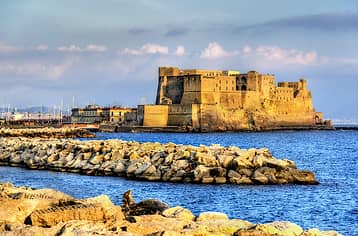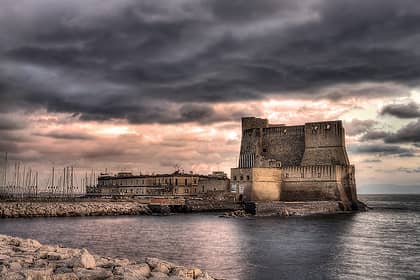Castel dell'Ovo


Castel dell'Ovo (literally translated from Italian as "Egg Castle”) is a medieval castle located in the historic district of Santa Lucia in central Naples. Built in the 12th century, it's the oldest castle in the city and one of the oldest in Italy. The castle was originally constructed to be used as a fortification against Saracen invaders, but has also been used as a prison and royal palace over the centuries. Today it is a popular tourist destination, offering great views of the city and fascinating history. The castle is one of the top sights in Naples and a must for any tour of Campania's regional capital.
The History of Castel dell'Ovo
The History of Castel dell'Ovo

Castel dell'Ovo is set on the small islet of Megaride off the Neapolitan coast overlooking the city and Gulf of Naples. This rock outcropping, today connected to the mainland by a narrow lip of land, is the oldest part of the city. It was here where the Greeks of Cuma founded the ancient metropolis of Partenope in the 8th century BC.
The Legend of the Siren
According to a very popular myth in ancient Greece, the body of the mermaid Parthenope was transported to Megaride from the depths of the sea after she had allowed herself to die following Ulysses' rejection. It is said that she is buried beneath Castel dell'Ovo and keeps watch over the city of Naples from her final resting place.
Putting aside ancient legends, Megaride once belonged to the powerful Roman general Lucius Licinius Lucullus, who built his Castrum Lucullanum villa on the outcropping. Later, the site become home to a monastery before the first version of the castle was built in 1140. Ruggiero the Norman fortified this area of the coast after the conquest of Naples with the castle and the Norman watchtower.
Like the other castles in Naples, over the centuries Castel dell'Ovo has undergone a series of renovations and extensions, the most important under Frederick II of Swabia in 1200 and Alfonso V of Aragon, who strengthened and expanded the fortress between 1400 and 1500. Additional batteries and two drawbridge were added during the reign of the Aragonese, the Spanish Vicelords, and later the Bourbons.
On clear days, you can make out Castel dell'Ovo from the top of Mt. Vesuvius.
The Legend of Virgil's Egg
The Legend of Virgil's Egg
The castle gets its name from an ancient legend linked to the Roman poet Virgil. According to local lore, Virgil hid a magic egg in the dungeons of the fortress, which protects it and has kept it standing over the centuries. If the egg ever breaks, it is said that the castle will collapse and a series of catastrophes will befall the city of Naples. During the reign of the Angevin queen Joan of England in the 14th century, the castle suffered a partial collapse that terrified the population. To calm the city's residents, the queen swore that she had replaced the "magic" egg (which, of course, has never been found over the centuries).
Highlights of the Castel dell'Ovo
Highlights of the Castel dell'Ovo

Castel dell’Ovo is an imposing building in yellow-hued tuff stone. The interiors are rather bare because its rooms are now used mainly for meetings, events, and conferences. That said, the castle deserves a visit not only for its architectural grandeur but also for its magnificent views of the Bay of Naples, Mt. Vesuvius, and the city center.
The Terrace of the Cannons offers a particularly beautiful view plus a collection of antique artillery to admire.
Sala Italia has a magnificent vaulted ceiling and visitors can admire frescoes and ancient capitals in the castle's Church of the Savior (not always open to visitors).
The surrounding area around the foot of the castle is occupied by the tiny but picturesque fishing village of Borgo Marinari and its marina, prestigious boating clubs, restaurants, and a few period buildings built against the walls of the fortress. Take a stroll along the moored boats, shipyards, and old-school seafood restaurants to take in its timeless atmosphere, especially in low season.
Learn more: What to see in one day in Naples
Getting to Castel dell’Ovo:
Getting to Castel dell’Ovo:

The fortress is located on Via Eldorado, 3 in the Santa Lucia district within walking distance from the centro storico. It is set in a pedestrian-only area of the city, so you must reach the sight on foot.
Depending upon where you are coming from in Naples, you can take the metro to Castel dell'Ovo, getting off at the Municipio stop along Line 1 and walking about 20 minutes to the Castle. You can also get off at Piazza Amedeo, though it's a slightly longer walk.
Otherwise, take bus 151 to Piazza Vittoria and walk for about 10 or 15 minutes along the panoramic Via Partenope. You can also get off at the Mergellina metro stop (Line 2) and continue on to Santa Lucia with bus 140.
The fortress is within walking distance of a number of city sights, including Teatro San Carlo, Piazza Plebiscito, Palazzo Reale (the Royal Palace), Galleria Umberto I, and Castel Nuovo (also known as the Maschio Angioino).
Castel dell'Ovo: Opening Hours, Tickets, and Tours
Castel dell'Ovo: Opening Hours, Tickets, and Tours
It is free to visit Castel dell'Ovo and you generally do not need to book in advance (except if you are traveling with a large group).
Opening Hours:
Monday to Saturday from 9:00 AM to 6:30 PM.
Sundays and holidays from 9:00 AM to 6:00 PM.
Visitors may be required to purchase a ticket when there is a temporary exhibition, show, or special event, at least access the portion of the castle being used to host the exhibition.
Guided tours of Castel dell'Ovo are periodically offered in different languages and depart from the main entrance of the fortress.